Dialogue The Global Environment Protection Activities of NTT West Group and Its Role in the Regional Community
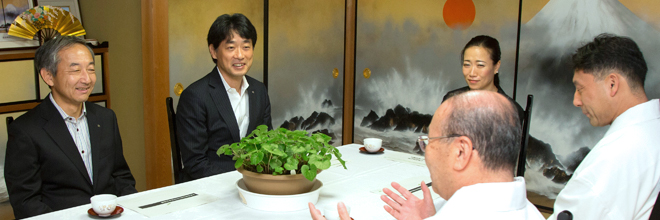
It is the month of June, a season with plants covered in brilliant green color. On June 3, a day when one can feel the breath and vitality of life, the seventh "Hollyhock Planting Event" was successfully held at Kamowakeikazuchi Shrine (commonly known as Kamigamo Shrine) located in Kita-ku of Kyoto City.
After the planting event, we invited Chief Priest Mr. Yasuhiro Tanaka and Priest Mr. Mitsutaka Inui from Kamigamo Shrine for a dialogue with NTT West representatives Mr. Yoshihiro Kuroda (Senior Executive Vice President), Mr. Yasuyuki Sasaki (Manager of Kyoto Branch) and Ms. Minako Hara (Manager of Environment Management Promotion Section) on the global environment protection activities of NTT West Group as well as the role that it plays in the regional community.
- Tanaka (Chief Priest):
We are thankful for the support by the large number of participants in the growing of hollyhocks every year since the launch of the "Afuhi Project."
As with past years, the leaves of the hollyhocks planted by the members of NTT West were used in the Kamo Festival this year.
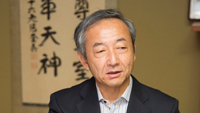
- Kuroda (Senior Executive Vice President):
We are grateful that NTT West Group is able to take part in this wonderful Afuhi Project.
It was the first time to see hollyhocks spreading across such a wide area. I believe this is the time when they look the greenest. Because they are grown in the precincts of Kamigamo Shrine, which is a special environment, I could feel the energy of the leaves and was overwhelmed by the breath of life.
- Sasaki (Branch Manager):
This is the second time that I take part in this activity after my first participation last year.
I'm glad to see the area for growing hollyhocks getting wider gradually, and I hope it will continue to widen in future. At the same time, I hope that our entire company will continue to contribute to this activity in the long term.
- Inui (Priest):
This year marks the seventh round of the planting event, and there are participants who have been taking part every time since it was first held. We are very grateful for their continued participation, and feel happy being able to greet them with words such as "we are glad to have you back again this year," which feels like an alumni gathering.
[Aoi Festival and Hollyhocks]
- MC:
On 15th of the last month, Kamo Festival (Aoi Festival) was held. This festival has been ongoing since the Heian era. An indispensable item needed for the Aoi Festival is the hollyhock.
First of all, can you tell us more about the Aoi Festival and the hollyhock plant?
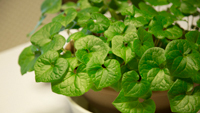
- Tanaka:
Decoration of hollyhocks at the Kamo Festival originated from an oracle, which claimed that the God of Kamowakeikazuchi will be able to descend safely on earth from heaven by holding a festival decorated with bundles of hollyhock plants and katsura (Japanese Judas tree) branches. People have been following this instruction of the god since 1450 years ago, and because a large number of hollyhocks are used for decorating this festival, it came to be known as the "Aoi Festival."
- MC:
This sounds exactly like what we would see in an ancient imperial picture scroll.
We know that hollyhocks are indispensable for the Kamo Festival, so how many are actually being used?
- Inui:
Hollyhocks are decorated not only in our shrine, but also at Shimogamo Shrine and Kyoto Gosho (Kyoto Imperial Palace), which add up to a total of 14,000 plants. There are two leaves on each stalk of hollyhock plant, and if we count in terms of the number of stalks, 14,000 stalks are used.
- Kuroda:
14,000, that's a lot. I believe a huge effort must be needed to create a sustainable environment for the growing of hollyhocks.
- Inui:
We have been engaging in efforts with the support from a large number of people to multiply the native hollyhock plants.
In fact, there is a town near our shrine that is named "Kamigamo-aoinomori-cho." Shimogamo Shrine is often referred to as "Tadasu no Mori (Forest of Atonement)," and judging from the name of the town and the connection between the two shrines, I believe Kamigamo Shrine used to be referred to as "Aoi no Mori." There were probably large quantities of hollyhock plants that were native to this area in the past.
- MC:
Were the hollyhocks eaten by wild animals living in the deep forest?
- Inui:
Lately, we are facing the problem of damage caused by deer that feed on the plants. We consulted people who are specialists in animal life, and were told that deer did not feed on hollyhocks in the past. However, it seems that when one member in a herd starts eating the plant, the others will follow suit with the understanding it is edible, and they would continue to eat up the entire patch.
- Kuroda:
We used to have a rich natural environment in the past, and it was probably easy for hollyhocks to grow too. It really makes us realize that we are living in an age when it is hard to achieve sustainability without making an effort.
- MC:
It is an invaluable experience indeed to plant hollyhocks, which are an essential item for a festival with a long history.
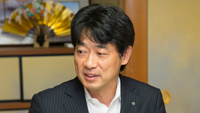
- Sasaki:
We are proud to be able to contribute to the Aoi Festival, which has a long history.
Besides the planting of hollyhocks, we also hold a "Afuhi Summit," which provides an opportunity to connect elementary school students from different regions via the Internet to learn about the protection of natural environment and cultural inheritance through the growing of hollyhocks.
- MC:
Is it an event to connect elementary school students in Kyoto City?
- Inui:
It is an exchange and learning event that targets at elementary and junior high school students from regions including the cities of Shizuoka and Hamamatsu in Shizuoka Prefecture, Sabae City in Fukui Prefecture as well as Tokyo connected via a videoconferencing system with Kamigamo Shrine in Kyoto as the key station.
- MC:
Are hollyhocks also grown in Shizuoka, Fukui and Tokyo?
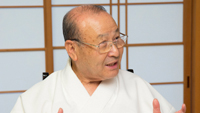
- Tanaka:
There are many places and elementary schools in different parts of Japan that have the word "Aoi" in their name, including Aoi Elementary School that is located beside the Sunpu Castle Park where the ruins of Sunpu Castle are found. Also, there are about 1000 Kamo Shrines throughout the country that enshrine the same deity as Kamigamo Shrine. We can still find the custom of using hollyhocks for decoration at the festivals of these regions and shrines.
We had the opportunity to present hollyhocks multiplied from those in our shrines to students of Aoi Elementary School in Shizuoka, who put in a lot of effort to grow the plants and returned the grown-up hollyhocks to us at the Kamo Festival in May.
- MC:
I heard that the students learn about things such as the growth of the hollyhocks and present their reports via the Internet, is that right?
- Inui:
We hold it once a year.
- Tanaka:
Thanks to the connection provided by the hollyhock, sixth grade students of Aoi Elementary School in Shizuoka began to visit Kyoto yearly for their school trip.
- MC:
Does the itinerary of their school trip include a visit to Kamigamo Shrine?
- Tanaka:
Yes, they would come visit our shrine after their visit to Kamigamo Elementary School that is just beside us for an exchange session with the students there over food catered by the school.
By forging ties with different regions, many elementary schools began to grow hollyhocks and we are very grateful for that.
- MC:
Is this activity unique to Kyoto Branch?
- Sasaki:
We also cooperate with branches in the respective regions in efforts initiated by the local regions.
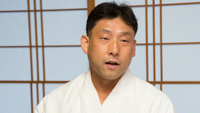
- Inui:
"Aoi Tsukai" is a ceremony for delivering hollyhocks to Sunpu Castle in Shizuoka. We presented a proposal to NTT West Kyoto Branch for this year's activity "to focus on the significance of 'forging ties' and to connect with the different branches," and they gladly accepted our proposal. So, after departing from Kyoto Branch, the hollyhocks passed through Shizuoka Branch before they were delivered to Sunpu Castle. These hollyhocks were then grown by the students of Aoi Elementary School in Shizuoka before they are finally returned during the Aoi Festival conducted by our shrine. This year also marks the 150th anniversary of Taisei Hokan (return of political power by the Tokugawa shogunate to the Emperor), which was a good timing to remind everyone of the long history of Japan and convey the importance and beauty of "forging ties."
- Kuroda:
The mission of our company is to establish connection via telephone and the Internet, and we are truly thankful to be able to take part in this project to forge connections through hollyhocks.
- MC:
I see. Hollyhocks play the role of connecting people with people, and children with children.
- Tanaka:
Starting from 1610, 10 years after the battle of Sekigahara, our shrine has been transferring beautifully-grown hollyhocks to pots and placing the pots in a Chinese-style chest, which were then delivered to the Tokugawa family. It was said that the shogun was delighted with the gift, which was brought all the way from Kyoto. This went on yearly for about 270 years until the Meiji era. The hollyhocks were first delivered to Sunpu Castle in Shizuoka, but the base was later shifted to Edo Castle by the second shogun, Tokugawa Hidetada. Back then, the deliverer was allowed to pass through the famous Pine Corridor of Edo Castle and enter the Shogun Room. A hefty sum of money was also received in return as an offering.
- MC:
The hollyhocks seem to play a very different role according to your description.
- Tanaka:
The third shogun, Tokugawa Iemitsu, helped to rebuild all the 60 halls in our shine.
Tofukumon-in, the daughter of the second shogun Hidetada, became the empress after she was married to Emperor Gomizunoo. When the chief priest of Kamigamo Shrine visited the Kyoto Imperial Palace for a new year greeting, he was told by Kyoto Shoshidai (governor of Kyoto) that the empress (Tofukumon-in) heard about the devastated state of Kamo Shrine, and suggested that the deities be temporarily moved for the shrine to be rebuilt.
While temples also existed in the precincts back then as both Shintoism and Buddhism were taught together, upon looking at the layout drawing of the precincts including the structure of the buildings that was presented to her, Tofukumon-in gave the consent for Tokugawa family to bear all the costs for the reconstruction.
- MC:
I see. So, it was a shrine of great importance.
- Tanaka:
Other than the main hall, all the structures still remain intact today after they were reconstructed by Tokugawa family 400 years ago.
- Kuroda:
This connection is forged thanks to the hollyhock.
- Tanaka:
Delivery of the hollyhocks was worth the while.


